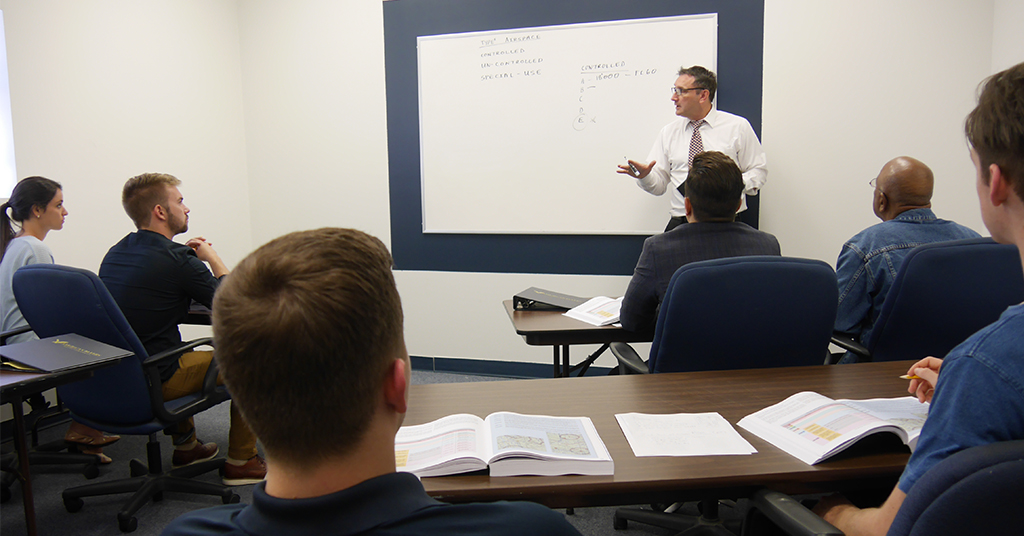By: Steven Daun, National Chief Pilot
You’ve dreamed about flying since you were knee-high to a grasshopper. You’re finally in a position in your life where this dream is about to become a reality. All your friends and family know that you are training to become a pilot. There is only one thing standing between you and your coveted certificate: the FAA Knowledge Exam, otherwise known as “The Written.”
There is a joke that I heard a few years ago that is relevant to this moment. “Two shoe salesmen are sent to a recently discovered tropical island. One salesman reports back to his company that there is no use. The island is full of natives but none of them wear shoes. The second salesman writes back to his company that they hit the gold mine. The island is full of natives that don’t wear shoes.”
The good news in your case is that the only thing standing between you and your certificate is the written. If you learned the information instead of memorizing the answers this won’t be a problem. To give you a little extra advantage, here are some tips and recommendations on how to prepare and pass your knowledge exam.
- It’s all in your mind: If you go to the class with the goal of learning then you will learn and enjoy the class. This is part of your training to become a pilot. What better way to spend a weekend than talking about flying with 5 or 10 other people just like you.
- Don’t memorize the answers: Your goal going into a written prep class should be to learn the information rather than memorizing the answers. If you lean the information properly then you won’t have to worry about what question is asked, you will know the answer. We see it hundreds of times each year. It takes people twice as long to prepare for the written by memorizing the answers. And in the long run, they end up paying an instructor to teach them the same information anyway. Do it right the first time.
- Don’t worry about your grade: Many of our students are successful business people and professionals. Their goal is to score a 100% on the written. The truth of the matter is that any grade over a 70% will yield you the same result; you pass. If you wait until you feel like you can score a 100% you will only delay your checkride and prolong your anxiety. At the end of the day, nobody will ever ask you what you scored on your written.
- Learn the “tip” not the “tricks”: There are many people who will give you their “tricks” for passing the written. You don’t need a “trick” if you understand the information. We will provide you with “tips” as we review the information in class. Our “tips” will show you how the questions are formulated based on the information that you are learning. The majority of these “tips” deal with how the question is phrased and weeding out the “almost right” answers.
- Eat, Drink and be Merry: Make sure that you eat well before and during your class. Bring a protein snack and bottle of water with you. Keep your sugar intake to a minimum. Drink plenty of fluids and don’t become frustrated. Each of these will ensure that your mind and body are ready to learn and your positive attitude will serve to enhance your motivation for success.
- Get some rest: Get a good night’s sleep before you take your Knowledge test. You have up to 3 hours in some cases to take your test. If you go in tired or groggy there is a good chance that you are going to rush through the second half of the test. Go to sleep early and schedule your test for the first test slot in the morning.
- Get to know the exhibit book: Every knowledge test has an associated exhibit book that is given to you before you begin. Many of these graphics are embedded in the test as well. While you are preparing for the knowledge test take some time to look through the exhibit book and make sure that you are clear on what many of the images are telling you. While the FAA no longer publishes the possible questions, you can be sure that the questions are going to reference the images in the exhibit book.
- Read the instructions: There are some questions on the knowledge test that pertains to graphs and performance charts. If you are not familiar with one or more of these don’t panic. Look at the whole graph or chart. In many cases, you will find instructions on the graph or chart that tell you how to use it.
- When in doubt, don’t guess: The adage is “when in doubt pick C.” This isn’t always true and does not always work to your benefit. When in doubt, mark the question. Yes, the testing software enables you to mark a question and return to it later. If you do this, there is a good chance that one or more of the next series of questions will help you formulate the correct answer to the skipped question. You shouldn’t have to guess on any question. Use logic and reasoning to the best of your ability.
- You don’t get the question: If you find yourself in a situation where you don’t understand the question, read all of the answers first. By doing this, most people find enough information to understand the original question.
- Housekeeping: Every testing center is different. While you cannot control the environment, you can control your tools. In this case, ask for at least two full-size and sharpened pencils with erasers. Nubby pencils and worn-down erasers can lead to sloppiness and mistakes. Your scratch paper should be a full size 8 ½ x 11 sheets without any writing, stains, or marks. The plastic graph overlays should be smooth without bends, creases, or marks. Your exhibit book, including all graphs and charts, should be clean and free of marks. Make sure that your computer monitor is clean as well. Many people write on the screens with pencils or markers and leave behind subtle marks. These can become distractions while taking your test.
- Identify problems early: If there is a problem with your testing computer, monitor or mouse let someone know ASAP. Don’t try to work around it. 100% of your focus and concentration should be on your test.
- The testing environment: Your knowledge test is an important part of your effort to earn your certificates and ratings. Because of this, you want to make sure that your testing environment is conducive to testing. Excessive noise outside or inside the testing room can be disturbing. Tell your test proctor if you believe that this will cause a distraction for you while you are taking the test. The lighting in the room should be adequate to enable you to read the exhibit book graphics.
- What do you do: Make sure that you clarify with the test proctor before you begin what their process is in case you need to use the restroom. Even though they will tell you, you should also make sure that you understand what to do when you get to the end of the test. You don’t want to do anything that would prevent you from obtaining your results.
- Be prepared: There are certain things that you will need to show the test proctor before they will allow you to take your knowledge test. You should organize these together the day before and make sure that you bring them with you to your test. You may want to take a few minutes a day or two before and call your testing center to review everything that you will need to bring with you. The critical items are:
- Photo I.D. (for U.S. Citizens & resident aliens)
- Driver’s license issued by a U.S. State or territory
- U.S. government I.D. card
- U.S. Military I.D card
- Passport or alien residency card
- Photo I.D. (for non-U.S. Citizens)
- Driver’s license issued by a U.S. State or territory and/or
- I.D. card issued by any government entity.
- Endorsement (signoff) for the written. Most of the FAA knowledge tests require an endorsement from your flight instructor.
- Photo I.D. (for U.S. Citizens & resident aliens)
- You become so nervous that you find yourself shutting down: If this happens to you, find your test proctor and ask to go get a drink of water and collect yourself. Throw some water on your face and drink some water. This will help you regroup so that you can continue.
- There is a question that stands out from the others in how it is phrased or deals with a subject that you may not be all that familiar with: This is normal. From time to time the FAA will add sample test questions to the knowledge Tests. This enables them to determine the effectiveness of the question and the relevance of the topic to current events. Don’t worry if you see one of these. Read the question and then the answers carefully. Select the one that makes the most sense to you.
- Don’t do the math in your head: We see this all of the time. A student reads a question quickly and thinks that it’s simple. They do the math in their head and it is usually incorrect. If you are working on a problem that deals with numbers, write the numbers down on your scratch paper and do the math on the paper. You will be more likely to find a mistake especially if the answer options are very close.
- Learn the ACS elements: The FAA publishes a document called Airman Certification Standards (ACS). These can be found by going to https://www.faa.gov/training_testing/testing/acs/ . While you don’t have to memorize them, you should read through them. These elements include all of the areas that appear on the FAA knowledge test. After you take your knowledge test you will see the element areas that you need to review with your instructor based on any questions that you may have missed.










